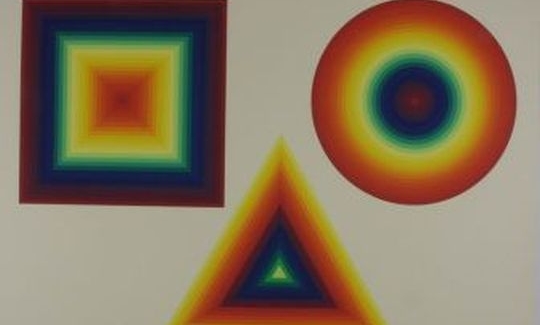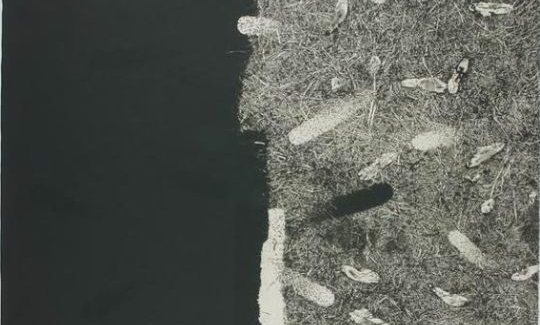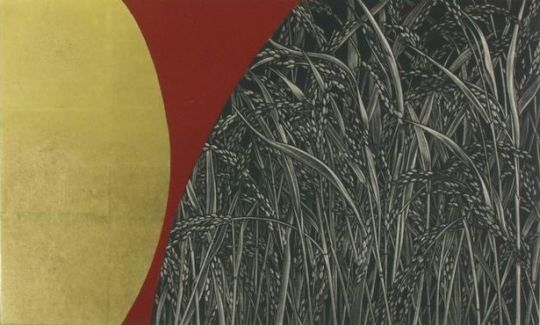Modern Japanese art is cosmopolitan, largely because of the current speed of information retrieval, the artists' ability to travel, and the international exhibition scene in which they participate. No more do we see the traditional woodblock prints of classical subjects from the "Floating World" (Ukiyo) - representations of Kabuki actors, landscapes, portraits of lovely pleasure girls, birds and flowers - that prevailed from the middle of the 17th century till the end of the 19th century. Today we find abstract and figurative subjects expressing the inner world of every artist, released from the proscriptions of publication in the past.
The traditional prints were usually prepared by three craftsmen - the artist who drew the design, the carver who prepared the block, and the printer. At the beginning of the 20th century, the Sosaku Hanga movement was started, in which the Japanese artists prepare every stage of the work themselves, seeing the process as intrinsic to their artistic expression. Many of them even use paper from the West instead of the handmade Japanese paper, and do not restrict themselves to the prescribed format of the traditional prints - the oban (37x25 cm.), chuban (28x21 cm.), hosoban (34x14 cm.), hashira-e (25x12 cm.) and others.
Following the encounter between Japanese and Western art, the graphic medium also changed. New types of media were brought to Japan - lithograph, silkscreen, etching and engraving. The traditional woodblock print and stencil techniques that have such a long and revered history in Japan no longer predominated.
The works in the exhibition are obviously very varied, both in subject and in style. All the artists express their own impressions of trends in today's art world and their individual approach to the environment, by means of a personal lexicon of expression. For example, in the etchings of Yanagisawa Noriko a male torso (frequently without a head) frequently appears, perhaps because the artist is trying to present the universal rather than the individual. Impressed on these figures, neither absolutely figurative nor abstract, there are fossils - "prints" created by nature. The works are divided into two equal sections representing actual and potential existence, and the wings which are also depicted are the means of aspiring to a new world, a new reality. The works of Noda Tetsuya, who calls them "A Diary", are also personal, the images in them taken from his travels and his daily activities - the corner with the shoes in the hall, the clock on the wall with Hebrew numerals.
However, traditional art has not been discarded in favour of the new, and contemporary art is a synthesis of influences from home and abroad. For instance, much emphasis is still placed on the empty space in these artists' works. In traditional Japanese art, this lacuna played a central role, and was considered as, at very least, equivalent in value to the object portrayed. This is still evident in the works of contemporary artists such as Amano Junji, Cho Haruko, Fudezuka Toshihisa, Ito Rie, Kiyohara Shizuko, Kobayashi Kiyoko, Nakabayashi Tadayoshi, Okada Marie, Shimada Setsuko, Sunaga Takahiro, Yamanaka Gen, and others. By means of a few lines and marks in an essentially empty space, they present to us a universe and all that it contains. Space and object in their works become a single entity, the object is not ‘something' resting on ‘nothing'. The balance between the two is not defined by means of symmetrical division, but by the relationship between the shape of the object and its spatial equilibrium in the picture.
Aki Mana, whose preferred medium is the woodcut, creates round, black patches in areas where the woodblock is not shaded with diagonal or horizontal lines. This monochromatic minimalism with its carefully restrained tonality is reminiscent of the traditional Japanese ink paintings. However, the subject matter of these contemporary works is usually abstract, influenced by conceptual art, surrealism, pop art and others. Nonetheless, we must not forget that the roots of artistic abstraction, and aesthetic values such as minimalism and symbolism, which appeared in the West only at the beginning of the 20th century, derive, in essence, from traditional Japanese art - the "No" Theatre established in the 14th century, or the ink drawings of the Zen monks, characterized by a few brush strokes and the empty space encompassing most of the area of the painting.
The synthesis between local art and influences acquired elsewhere is also expressed by "quotations" from traditional Japanese art in works whose expression is no longer identical with that of the past. In the works of Nakazato Hitoshi, the compositions consist of a circle, a triangle and a square, and the titles of his works include the phrase "Sen-gai" ("Line Outside"). Using other ideograms, this is also the name of the Zen monk and artist Sengai Gibon (1750-1837), who made a famous ink-drawing of the same elements. The composition by Ay-o also includes these three elements, but instead of monochromatic ink, as in Sengai's drawing, he employs all the colours of the rainbow. The artist Hamanishi Katsunori also "quotes" traditional Japanese art in his work, attaching square plaques of gold leaf to the surface of the paper just as they used it on the folding screens and sliding doors of the aristocratic dwellings of Japan.
The contemporary Japanese print is certainly an art form that flourishes in the tempo of today, and seems to be absolutely universal. But regard for aesthetic finesse expresses the integration of the artistic heritage of the past. In today's world, the use of varied printing techniques, international modes of expression, and differences of content allow the artists to express universal themes in their own personal manner. However, all of them share at least one quality, namely, complete control over their techniques and a high degree of expertise in their immaculate creations. Integrity and perfection are, without doubt, the predominant elements in the heritage of Japanese art.
The "50" Exhibition opens the Tikotin Museum of Japanese Art's exhibition programme for 2002, the jubilee anniversary of the establishment of diplomatic ties between Israel and Japan. It is the fruit of the combined initiative of Mr. Yuji Abe, Director of the Yoseido Gallery in Tokyo, and the Tikotin Museum. In honour of this festive occasion, the Museum presents the works of 50 contemporary Japanese print artists of the first rank. Many of these artists have generously decided to donate some of their works to the Museum after the exhibition closes.




